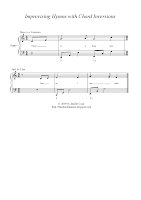Chord inversions add variety when improvising hymns.
A root chord such as C E G (consecutive thirds) can be inverted
two different ways for variety in sound.
See the following link for a simple explanation of chord inversions.
http://thechurchpianist.blogspot.com/2009/02/church-piansit-using-chord-inversions.html
The following scenario makes good use of chord inversions.
When one chord lasts for at least 4 beats....the left hand
can invert the chord (same chord...just in a different note
order).
Example #1 (There is a Fountain) *See image below
The first left hand broken chord begins with the note "C"
"C" is the root of the C chord....so this broken chord would
be considered the root chord (even though E and G swapped
places for a more open tone).
The second broken chord of the left hand begins on note "E".
This is still a broken C chord but....considered in first inversion.
The true order of the C (first inversion) is EGC....but G and C
swapped places to create a more open tone.
Basically, the bass note dictates what chord inversion is being used.
But...you have to look at the complete picture for this analysis.
Meaning...notes in both hands must be combined for proper
chord analysis.
Special note:
A chord in 1st inversion is labeled with the number six (6)
Why? Well...remember that the notes in the first inversion
of a C chord are: E G C
The note "G" is the 6th note from the bottom note (E)
The same left hand chord pattern occurs in "Just As I Am".
What a mouthful! Hope this makes sense. Feel free to ask
questions if needed.
Chord inversions add color to improvising!




No comments:
Post a Comment